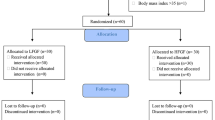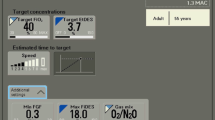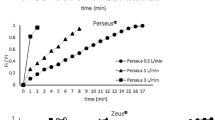Abstract
During the wash-in period in low flow anaesthesia (LFA), high fresh gas flow is used to achieve the desired agent concentration. In this study, we aimed to evaluate the safety of fixed 1 L/min fresh gas flow desflurane anaesthesia in both the wash-in and maintenance periods in patients including the obese ones. 104 patients undergoing surgery under general anaesthesia were included. After endotracheal intubation, fresh gas flow was reduced to 1 L/min and the desflurane vaporizer was set at 18%. The time from opening the vaporizer to end-tidal desflurane concentration reaching 0.7 MAC was recorded (MAC 0.7 time). Throughout the surgery, hemodynamic variables, FIO2, MAC and BIS values were observed. MAC 0.7 time, BIS and MAC values at the start of surgery, number of adjustments in vaporizer settings, desflurane consumption were recorded. The average MAC 0.7 time was 2.9 ± 0.5 min. MAC and BIS values at the start of the surgery were 0.7 (0.6–0.8) and 39 ± 8.5 respectively. No individual patient had a BIS value above 60 throughout the surgery. Hemodynamic variables were stable and FIO2 did not fall below 30% in any patient. The number of adjustments in vaporizer settings was 56. Average desflurane consumption was 0.33 ± 0.05 mL/min. We demonstrated that LFA without use of initial high fresh gas flow during the wash-in period is an effective, safe and economic method which is easy to perform.





Similar content being viewed by others
References
Brattwall M, Warrén-Stomberg M, Hesselvik F, Jakobsson J. Brief review: theory and practice of minimal fresh gas flow anesthesia. Can J Anaesth. 2012;59(8):785–97.
Bilgi M, Goksu S, Mizrak A, Cevik C, Gul R, Koruk S, et al. Comparison of the effects of low-flow and high flow inhalational anaesthesia with nitrous oxide and desflurane on mucociliary activity and pulmonary function tests. Eur J Anaesthesiol. 2011;28(4):279–83.
Mapleson WW. The theoretical ideal fresh-gas flow sequence at the start of low-flow anaesthesia. Anaesthesia 1998;53(3):264–72.
Hendrickx JF, Dewulf BB, De Mey N, Carette R, et al. Development and performance of a two-step desflurane-O2/N2O fresh gas flow sequence. J Clin Anesth. 2008;20(7):501–7.
Sathitkarnmanee T, Tribuddharat S, Suttinarakorn C, et al. 1-1-12 one-step wash-in scheme for desflurane-nitrous oxide low-flow anesthesia: rapid and predictable induction. Biomed Res Int. 2014. https://doi.org/10.1155/2014/867504.
Hendrickx JF, Lemmens H, De Cooman S, et al. Mathematical method to build an empirical model for inhaled anesthetic agent wash-in. BMC Anesthesiol. 2011;11:13.
Mashour GA, Shanks A, Tremper KK, et al. Prevention of intraoperative awareness with explicit recall in an unselected surgical population: a randomized comparative effectiveness trial. Anesthesiology 2012;117(4):717–25.
Avidan MS, Jacobsohn E, Glick D, Burnside BA, Zhang L, Villafranca A, Karl L, Kamal S, Torres B, O’Connor M, Evers AS, Gradwohl S, Lin N, Palanca BJ, Mashour GA. BAG-RECALL Research Group: prevention of intraoperative awareness in a high-risk surgical population. N Engl J Med. 2011;365(7):591–600.
Ip-Yam PC, Goh MH, Chan YH, Kong CF. Clinical evaluation of the Mapleson theoretical ideal fresh gas flow sequence at the start of low-flow anaesthesia with isoflurane, sevoflurane and desflurane. Anaesthesia 2001;56:160–4.
Horwitz M, Jakobsson JG. Desflurane and sevoflurane use during low- and minimal-flow anesthesia at fixed vaporizer settings. Minerva Anestesiol. 2016;82:180–5.
Gan TJ, Glass PS, Windsor A, et al. Bispectral index monitoring allows faster emergence and improved recovery from propofol, alfentanil, and nitrous oxide anesthesia. BIS Utility Study Group. Anesthesiology 1997;87(4):808–15.
Ekman A, Lindholm ML, Lennmarken C, Sandin R. Reduction in the incidence of awareness using BIS monitoring. Acta Anaesthesiol Scand. 2004;48(1):20–6.
Myles PS, Leslie K, McNeil J, Forbes A, Chan MT. Bispectral index monitoring to prevent awareness during anaesthesia: the B-Aware randomised controlled trial. Lancet. 2004;363(9423):1757–63.
McKay RE. Inhaled anesthetics. In: Strales LM, Miller RD. Miller’s anesthesia review. 2nd ed. Philadelphia: Saunders; 2013. p. 45.
Ebert TJ, Muzi M. Sympathetic hyperactivity during desflurane anesthesia in healthy volunteers: a comparison with isoflurane. Anesthesiology 1993;79(3):444–53.
Weiskopf RB, Cahalan MK, Eger El 2nd, Yasuda N, et al. Cardiovascular actions of desflurane in normocarbic volunteers. Anesth Analg. 1991;73(2):143–56.
Lucangelo U, Garufi G, Marras E, Ferluga M, Turchet F, Bernabè F, Comuzzi L, Berlot G, Zin WA. End-tidal versus manually-controlled low flow anaesthesia. J Clin Monit Comput. 2014;28(2):117–21. https://doi.org/10.1007/s10877-013-9516-8.
Baum JA. Low-flow anesthesia: theory, practice, technical preconditions, advantages, and foreign gas accumulation. J Anesth. 1999;13:166–74.
Author information
Authors and Affiliations
Corresponding author
Ethics declarations
Conflict of interest
The authors declare no conflict of interest.
Ethical approval
All procedures performed in studies involving human participants were in accordance with the ethical standards of the institutional and/or national research committee and with the 1964 Helsinki declaration and its later amendments or comparable ethical standards. The study was approved by the Ethics Committee of the Healthcare Application and Research Hospital of Kahramanmaras Sutcu Imam University (no.154 dated 04.05.2016).
Rights and permissions
About this article
Cite this article
Bahar, S., Arslan, M., Urfalioglu, A. et al. Low-flow anaesthesia with a fixed fresh gas flow rate. J Clin Monit Comput 33, 115–121 (2019). https://doi.org/10.1007/s10877-018-0135-2
Received:
Accepted:
Published:
Issue Date:
DOI: https://doi.org/10.1007/s10877-018-0135-2




